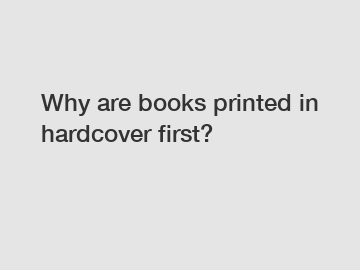Why are books printed in hardcover first?
Why are books printed in hardcover first?
Hardcover books have long been a staple in the world of literature. Their sturdy construction, aesthetically pleasing appearance, and perceived value have made them a popular choice among avid readers and collectors alike. However, have you ever wondered why books are often printed in hardcover before being released in paperback? Let's delve into this fascinating topic and explore the reasons behind this publishing practice.
2. Historical perspective on hardcover books.

To understand why books are initially printed in hardcover, it's essential to take a trip back in time. Prior to the invention of the printing press, books were painstakingly handcrafted by skilled scribes, making them extremely rare and expensive. Only the affluent could afford to own books, which were primarily made from durable materials like parchment. These early books were the precursors of the modern hardcover, embodying the association of prestige and durability that is still ingrained in our perception of hardback editions.
3. Perceived value and durability.
One of the main reasons books are printed in hardcover first is the perceived value they accord to the content within. Hardcover books exude a sense of luxury and quality, making them desirable for both collectors and gift buyers. The weight, glossy dust jackets, and overall presentation contribute to their appeal. Additionally, hardcovers are more durable than paperbacks, which tend to wear down over time. For books expected to have a longer shelf life, such as classics or reference materials, starting with a hardcover edition ensures longevity and lends an air of permanence.
4. Marketing and sales strategy.
Publishers often release books in hardcover first as part of their marketing and sales strategy. Hardcover editions command a higher price point, resulting in increased revenue for publishers, authors, and retailers. This initial wave of revenue helps recoup production costs and generates buzz around a book's release. By targeting avid readers, collectors, and libraries who prefer hardcover editions, publishers can create a sense of exclusivity and enhance anticipation for the subsequent paperback release.
5. Library and collector appeal.
Another factor contributing to the printing of hardcover editions initially is their appeal to libraries and book collectors. Libraries often prefer hardcovers due to their increased durability, especially for high-demand books that experience heavy circulation. Additionally, hardcover books increase the chances of being purchased by collectors, who value the aesthetic appeal, rarity, and potential for future appreciation. By catering to these specialized markets, publishers can maximize their audience reach.
6. Perceived higher quality.
Many readers associate hardcover editions with higher quality and seriousness of content. This perception stems from the historical association between hardcovers and centuries-old literary classics. Hardcovers provide a sense of weight and importance, which can impact how a book is regarded by readers, critics, and even award committees. This association between hardcover books and literary merit can influence readers' purchasing decisions and enhance an author's professional reputation.
7. Cost considerations and practicality.
While hardcover books offer numerous benefits, their production comes at a higher cost compared to paperbacks. The printing process, binding, and additional materials all contribute to the increased expenses associated with hardcover editions. Thus, publishers often take into account the sales potential and demand for a particular book before deciding to invest in a hardcover print run. This cost consideration is also why some books skip the hardcover phase entirely and release directly in paperback.
8. Conclusion.
In conclusion, there are several reasons why books are often printed in hardcover first. The appeal of hardcovers lies in their perceived value, durability, and attractiveness to collectors and libraries. Additionally, hardcovers serve as a key marketing and sales strategy, generating revenue and building anticipation for subsequent paperback releases. Although hardcovers may come at a higher cost, they offer a sense of quality and prestige that can enhance the reader's experience and the author's reputation. Ultimately, whether you prefer hardcover or paperback editions, it's the content within the pages that truly matters.
Contact us to discuss your requirements of cnprint, linen covers hardcover book, hardcover book printing with embossing. Our experienced sales team can help you identify the options that best suit your needs.


